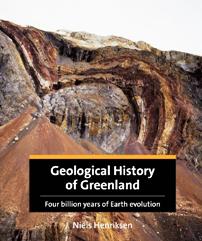
This beautifully produced volume summarises the results of more than 60 years of geological investigations in Greenland and the surrounding shelf areas. Greenland’s exceptionally well exposed mountainous arctic landscape preserves evidence for close to four billion years of Earth evolution and continues to attract significant international research interest. The substantial areas of Precambrian basement exposed have in particular yielded crucial insights into the evolution of the early Earth. Generations of UK university researchers have participated in the summer expeditions that mapped this remote terrain and contributed to present understanding.
The key features of the volume include its generous size (30 x 25cm), the splendid photographic images and accessible colour diagrams, and the way in which has been presented in a form that is suitable not only for the general, interested reader, but also for students and geologists without specialist knowledge of Greenland geology. Introductory chapters set the scene, with a brief review of Greenland’s geological evolution from the Eoarchaean to the Quaternary, a history of research, and a synthesis of the way in which ice has moulded the landscape. Then follow chapters that deal in turn with the crystalline basement, the Gardar Province, Proterozoic to Ordovician sedimentary basins, the development of the Caledonian and Ellesmerian fold belts, Upper Palaeozoic to Palaeogene basins, and Palaeogene volcanism. Summaries of the geology offshore and the Quaternary glacial history are followed by chapters on mineral, oil and gas resources. All are copiously illustrated with a mix of field photographs (including numerous stunning images of mountain-scale structures and rock successions), palaeogeographic maps and other specially drawn colour diagrams (e.g. sketch cross-sections, sedimentary logs, geophysical profile).
The diversity of geology within Greenland means that no major processes are left untouched within the book. Highlighted blocks of text accompanied by well presented and easily readable diagrams explain basic geological concepts for the non-specialist as the book progresses. These include subjects as wide-ranging as basic rock identification, geological mapping, deep-sea drilling, and the generation of oceanic crust. This is a particularly strong feature of the book. Indeed, it could be argued that this is just as effective an introductory text book for geology undergraduates as any of the commonly used examples in the UK and abroad. In summary, this is an outstanding contribution to the Earth sciences literature. It is one of the best books available on geology for a broader public, but will still manage to satisfy the academic or industry-based geologist who wishes for an update on the geology of this perennially fascinating piece of the Earth’s crust. No library should be without a copy.
Rob Strachan, Portsmouth